Fuel Tank Replacement Single Tank
Removal Procedure
Important: Clean the fuel and evaporative emission (EVAP) connections and surrounding areas prior to disconnecting the lines in order to avoid possible system contamination.
- Relieve the fuel system pressure. Refer to Fuel Pressure Relief .
- Drain the fuel tank. Refer to Fuel Tank Draining .
- Disconnect the vent hose quick connect fitting from the fuel tank. Refer to Plastic Collar Quick Connect Fitting Service
- Disconnect the fuel feed and EVAP lines from the fuel tank lines. Refer to Plastic Collar Quick Connect Fitting Service .
- Cap the fuel and EVAP lines in order to prevent possible fuel and/or EVAP system contamination.
- Disconnect the EVAP lines from the EVAP canister. Refer to Plastic Collar Quick Connect Fitting Service .
- Using an adjustable jack, support the fuel tank.
- Remove the fuel tank strap bolts.
- Remove the fuel tank straps.
- With the aid of an assistant, carefully lower the rear of the fuel tank.
- Slide the front of the tank away from the frame.
- Lower the fuel tank slightly until the electrical connectors can be accessed.
- Disengage the sending unit connector position assurance (CPA) retainer.
- Disconnect the sending unit and fuel pressure sensor electrical connectors.
- Completely lower the fuel tank.
- With the aid of an assistant, Place the fuel tank in a suitable work area.
- If necessary, open the clip on the fuel tank and remove the fuel feed and EVAP lines.
- If necessary, remove the fuel sending unit. Refer to Fuel Sender Assembly Replacement .


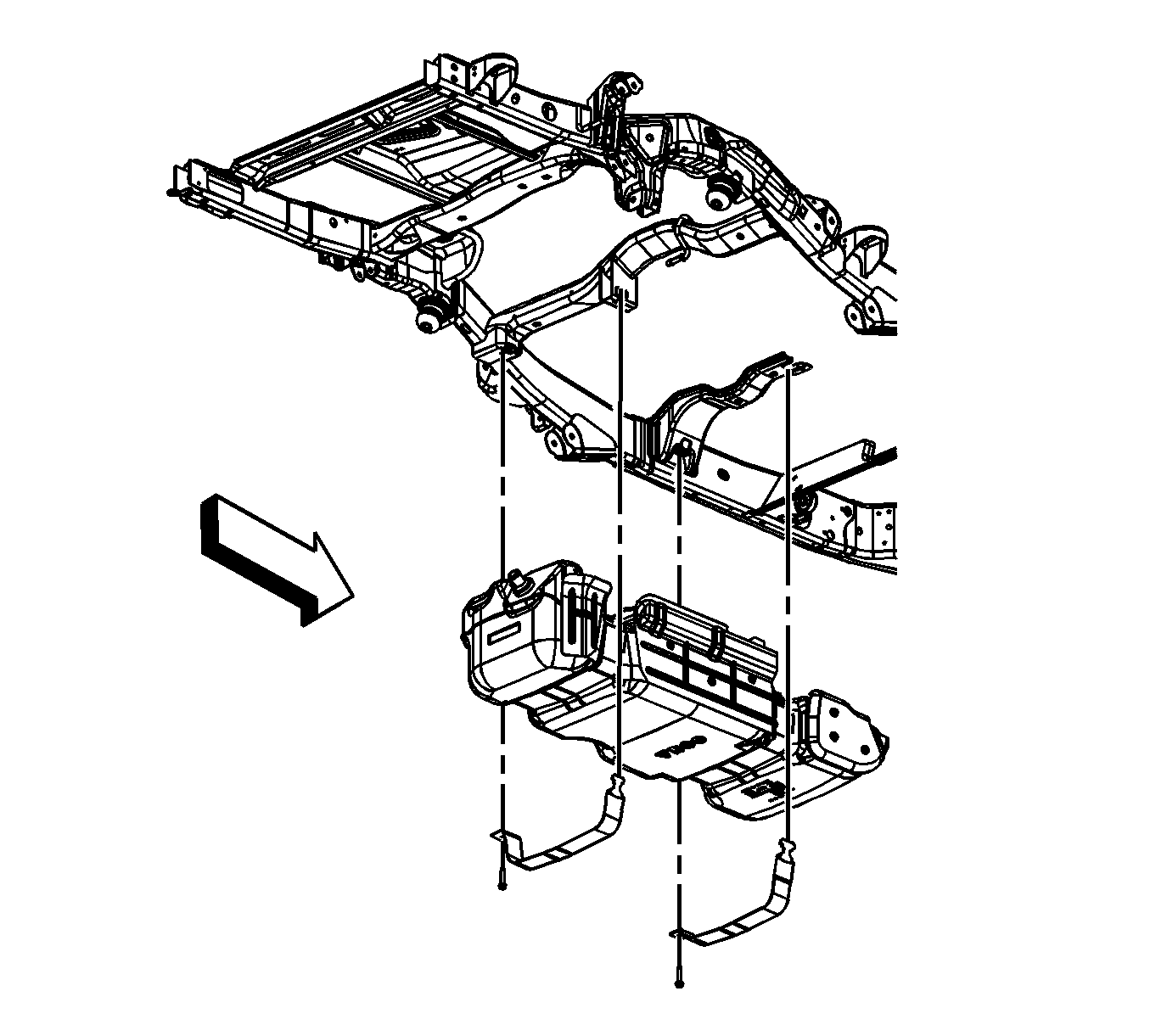
Notice: Do not bend the fuel tank straps. Bending the fuel tank straps may damage the straps.

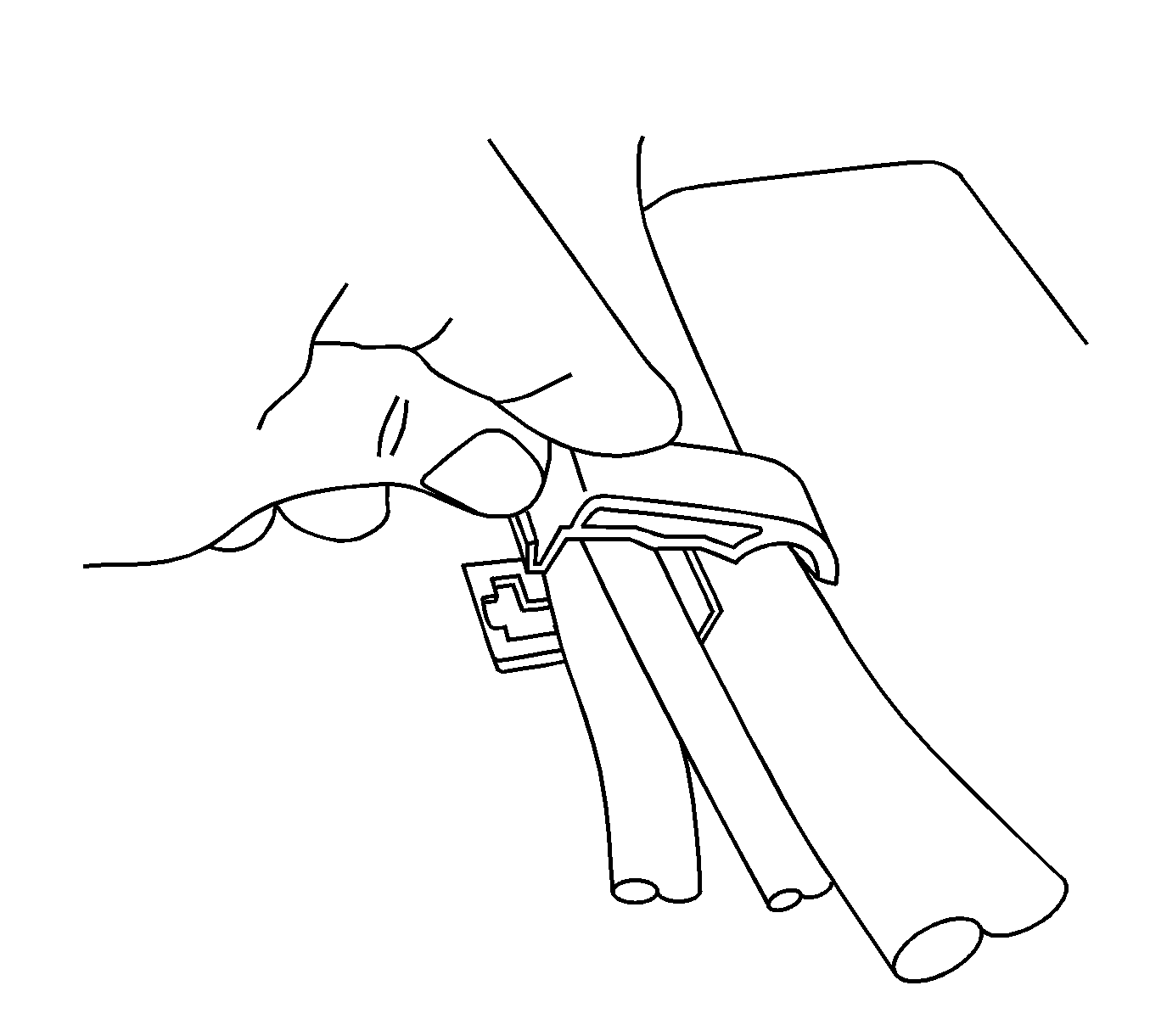
Installation Procedure
- If necessary, install the fuel sending unit. Refer to Fuel Sender Assembly Replacement .
- If necessary, install the fuel feed and EVAP lines to the clip on the fuel tank. Close the clip.
- Place the fuel tank onto a suitable jack.
- With the aid of an assistant, partially raise the fuel tank.
- Connect the fuel sender and fuel pressure sensor electrical connectors.
- Engage the CPA retainer.
- Completely raise the fuel tank.
- Install the fuel tank straps.
- Install the fuel tank strap bolts.
- Remove the adjustable jack from the fuel tank.
- Connect the vent line quick connect fitting. Refer to Plastic Collar Quick Connect Fitting Service .
- Install the fill hose to the fuel tank.
- Tighten the fill hose clamp at the tank.
- If necessary, tighten the fill pipe bracket bolts.
- Remove the caps from the fuel and EVAP pipes.
- Connect the EVAP lines to the EVAP canister. Refer to Plastic Collar Quick Connect Fitting Service .
- Connect the fuel and EVAP lines to the fuel tank lines. Refer to Plastic Collar Quick Connect Fitting Service .
- Lower the vehicle.
- Refill the fuel tank.
- Install the fuel fill cap.
- Connect the negative battery cable. Refer to Battery Negative Cable Disconnection and Connection in Engine Electrical.
- Use the following procedure in order to inspect for leaks:



Notice: Use the correct fastener in the correct location. Replacement fasteners must be the correct part number for that application. Fasteners requiring replacement or fasteners requiring the use of thread locking compound or sealant are identified in the service procedure. Do not use paints, lubricants, or corrosion inhibitors on fasteners or fastener joint surfaces unless specified. These coatings affect fastener torque and joint clamping force and may damage the fastener. Use the correct tightening sequence and specifications when installing fasteners in order to avoid damage to parts and systems.
Tighten
Tighten the bolts to 40 N·m (30 lb ft).
Tighten
Tighten the clamps to 2.5 N·m (22 lb in).
Tighten
Tighten the bolts to 12 N·m (106 lb in).


| 22.1. | Turn the ignition ON, with the engine OFF, for 2 seconds. |
| 22.2. | Turn the ignition OFF for 10 seconds. |
| 22.3. | Turn the ignition ON, with the engine OFF. |
| 22.4. | Inspect for fuel leaks. |
Fuel Tank Replacement Dual Tanks - Front
Removal Procedure
Important: Clean all fuel and evaporative emission (EVAP) line connections and surrounding areas prior to disconnecting the lines in order to avoid possible fuel and/or EVAP system contamination.
- Relieve the fuel system pressure. Refer to the Fuel Pressure Relief .
- Drain the fuel tank. Refer to Fuel Tank Draining .
- Disconnect the evaporative emission (EVAP) vent line from the fuel tank line. Refer to Plastic Collar Quick Connect Fitting Service .
- Disconnect the vapor line (1) from the fuel tank. Refer to Plastic Collar Quick Connect Fitting Service .
- Disconnect the fuel feed and EVAP lines from the fuel tank. Refer to Plastic Collar Quick Connect Fitting Service .
- Open the clip on the side of the fuel tank retaining the intermediate lines.
- Disconnect the fuel and EVAP intermediate lines from the front tank. Refer to Plastic Collar Quick Connect Fitting Service .
- Cap the fuel and EVAP lines in order to prevent possible fuel/EVAP system contamination.
- If equipped, remove the fuel tank shield bolts.
- If equipped, remove the fuel tank shield.
- Using an adjustable jack, support the fuel tank.
- Remove the fuel tank strap bolts.
- Remove the fuel tank straps.
- With the aid of an assistant, carefully lower the fuel tank until the sending unit is accessible.
- Disengage the connector position assurance (CPA) retainer.
- Disconnect the sending unit electrical connector.
- Completely lower the fuel tank.
- Place the fuel tank in a suitable work area.
- If necessary, remove the sending unit. Refer to Fuel Sender Assembly Replacement .
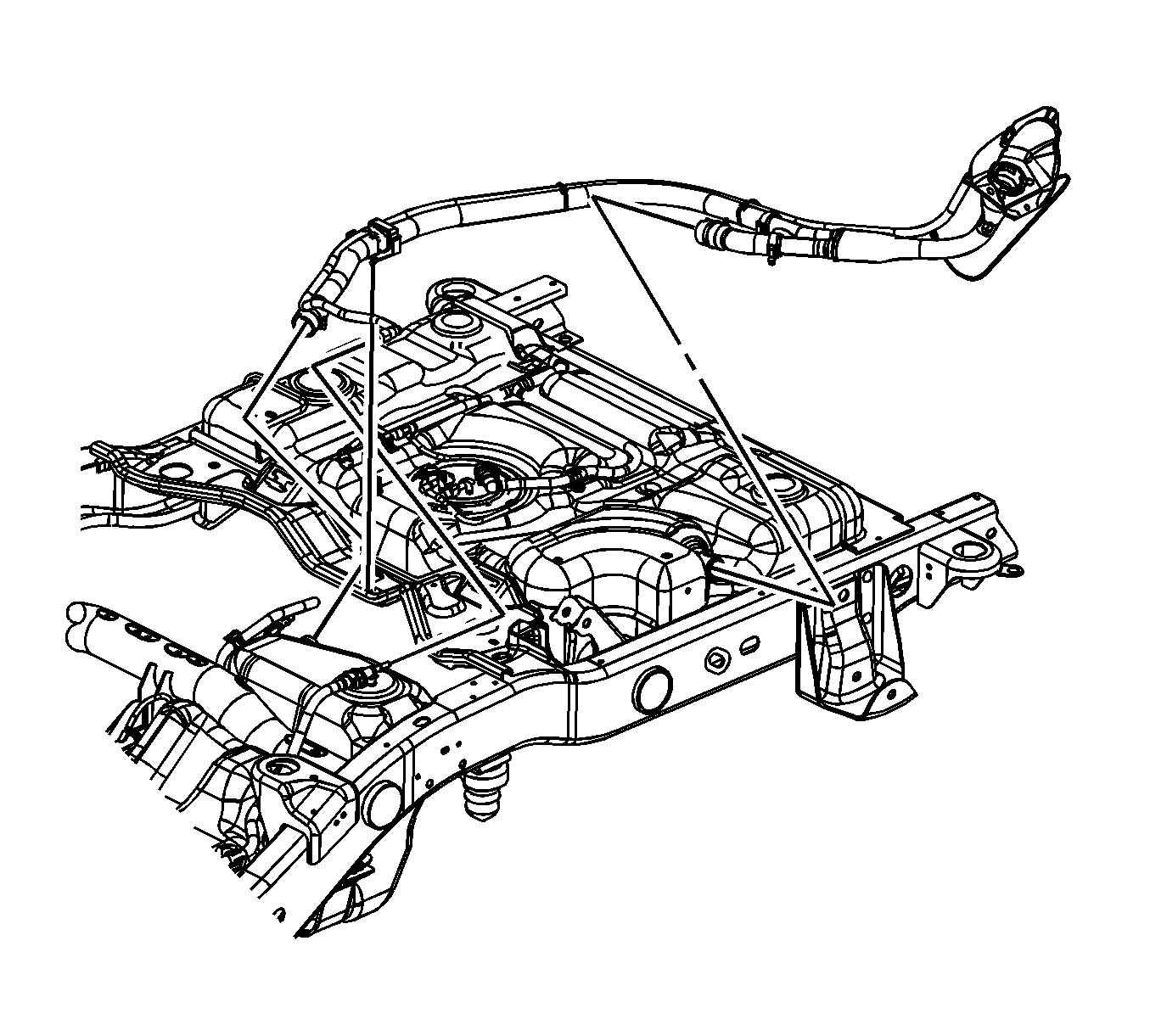

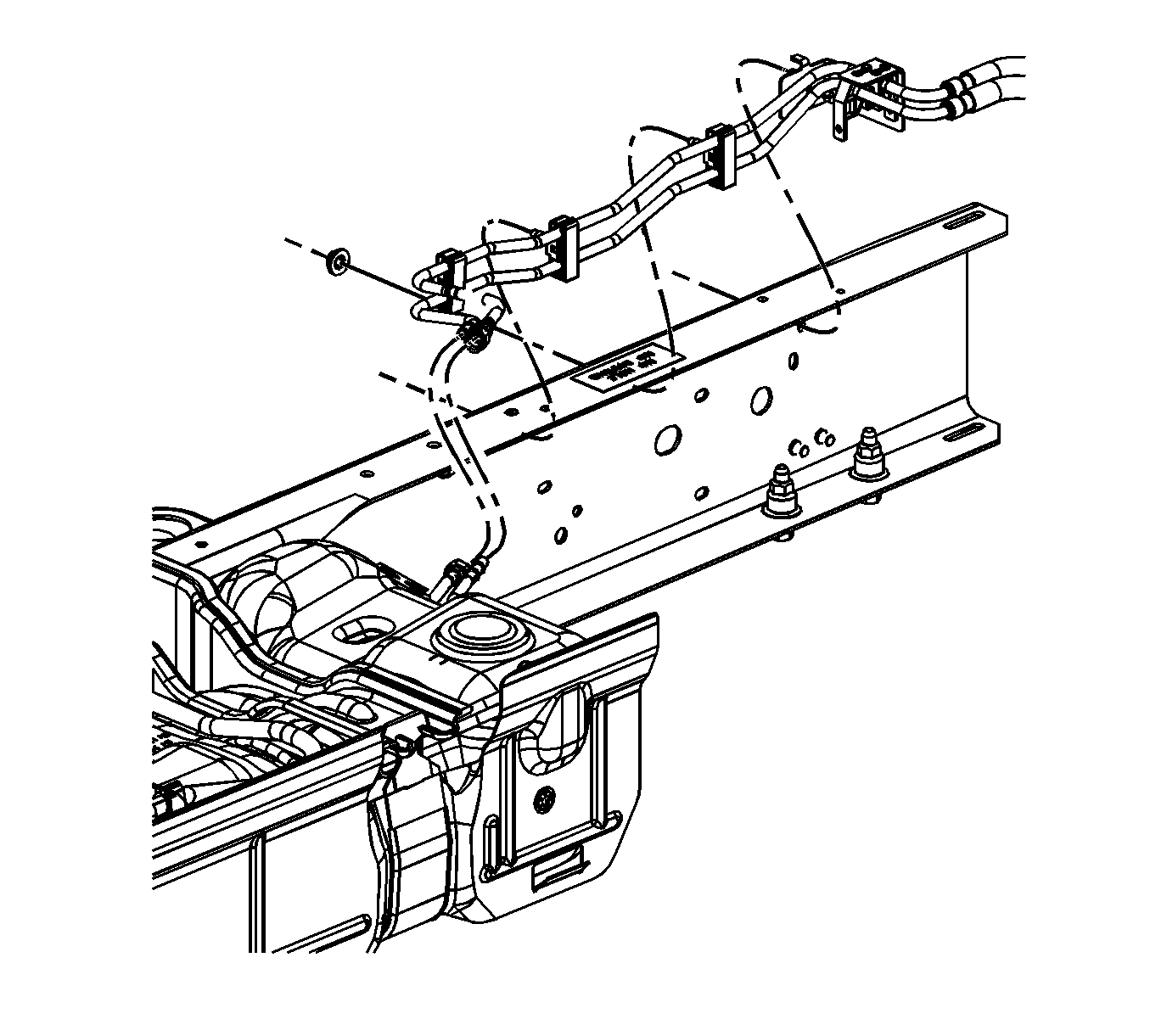

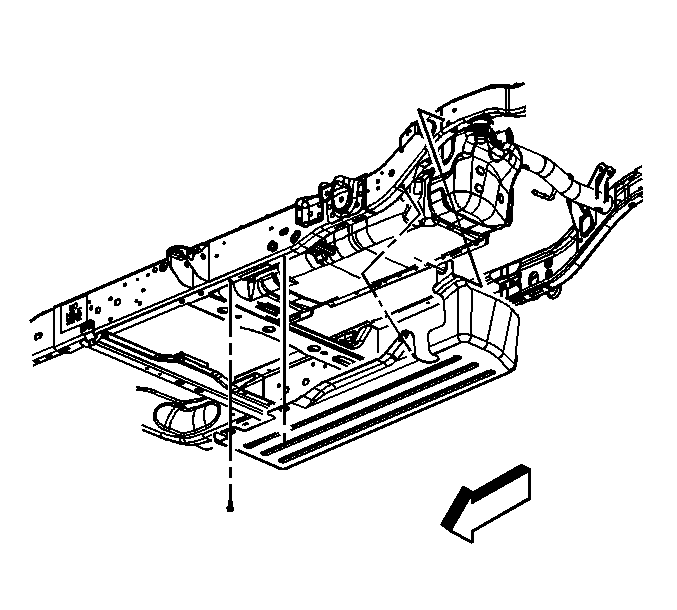
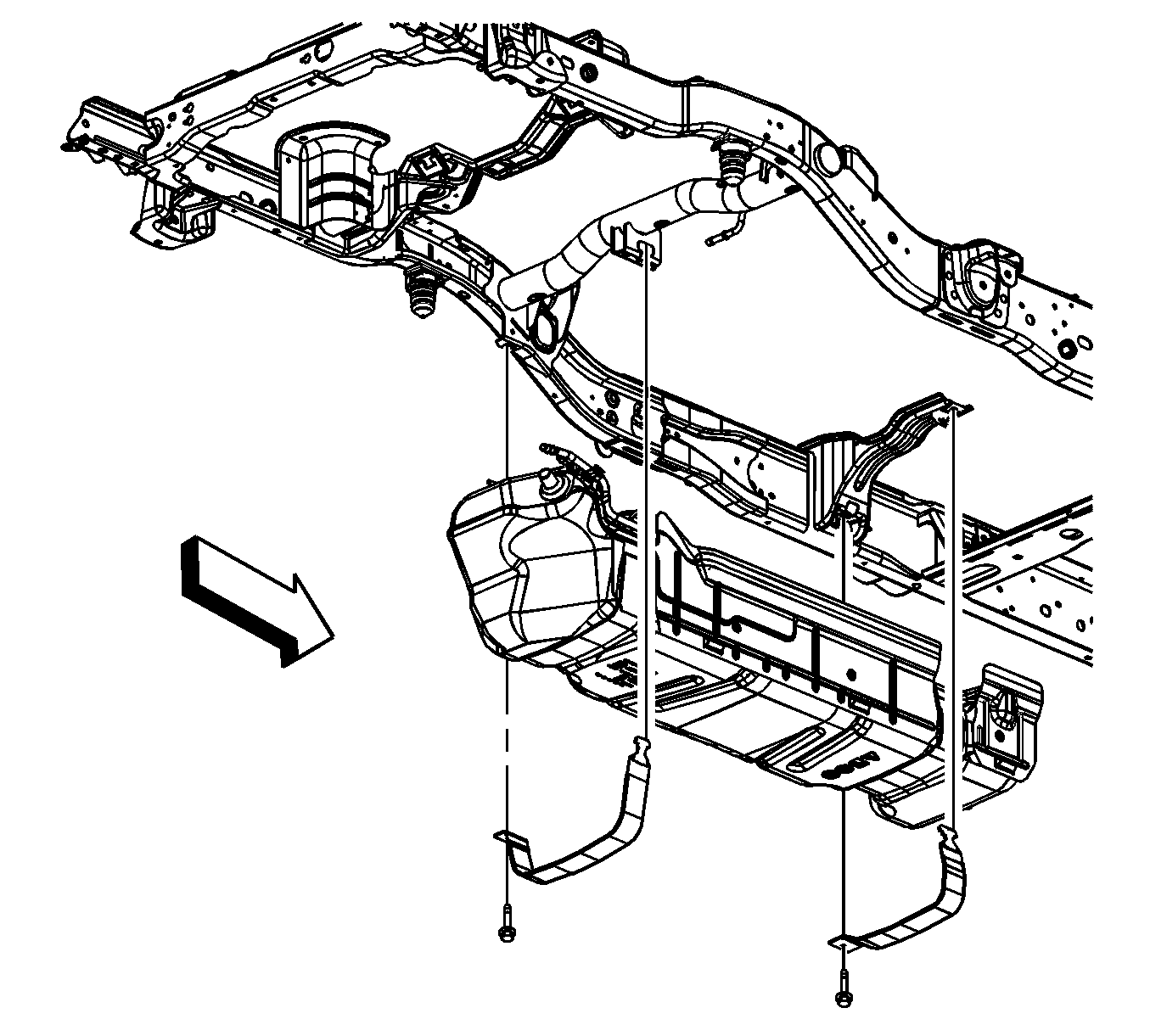
Notice: Do not bend the fuel tank straps. Bending the fuel tank straps may damage the straps.

Installation Procedure
- If necessary, install the sending unit. Refer to Fuel Sender Assembly Replacement .
- Place the fuel tank onto a suitable jack.
- With the aid of an assistant, partially raise the fuel tank.
- Connect the sending unit electrical connector.
- Engage the CPA retainer.
- With the aid of an assistant, completely raise the fuel tank.
- Install the fuel tank straps.
- Install the fuel tank strap bolts.
- Remove the adjustable jack from under the fuel tank.
- If equipped, install the fuel tank shield.
- If equipped, install the fuel tank shield bolts.
- Remove the caps from the fuel and EVAP pipes.
- Connect the fuel and EVAP intermediate lines to the front tank. Refer to Plastic Collar Quick Connect Fitting Service .
- Close the clip on the side of the fuel tank retaining the intermediate lines.
- Connect the fuel feel and EVAP lines to the fuel tank. Refer to Plastic Collar Quick Connect Fitting Service .
- Connect the vapor line (1) to the fuel tank. Refer to Plastic Collar Quick Connect Fitting Service .
- Connect the EVAP vent line to the fuel tank. Refer to Plastic Collar Quick Connect Fitting Service .
- Install the fuel fill hose to the fuel tank.
- Tighten the fuel fill hose clamp at the fuel tank.
- Lower the vehicle.
- Refill the fuel tank.
- Install the fuel fill cap.
- Connect the negative battery cable. Refer to Battery Negative Cable Disconnection and Connection in Engine Electrical.
- Use the following procedure in order to inspect for leaks:


Notice: Refer to Fastener Notice in the Preface section.
Tighten
Tighten the bolts to 40 N·m (30 lb ft).

Tighten
Tighten the bolts to 15 N·m (11 lb ft).




Tighten
Tighten the clamp to 2.5 N·m (22 lb in).
| 24.1. | Turn the ignition ON, with the engine OFF, for 2 seconds. |
| 24.2. | Turn the ignition OFF for 10 seconds. |
| 24.3. | Turn the ignition ON, with the engine OFF. |
| 24.4. | Inspect for fuel leaks. |
Fuel Tank Replacement Dual Tanks - Rear
Removal Procedure
Important: Clean all fuel and evaporative emission (EVAP) line connections and surrounding areas prior to disconnecting the lines in order to avoid possible fuel and/or EVAP system contamination.
- Relieve the fuel system pressure. Refer to the Fuel Pressure Relief .
- Remove the spare tire stowage lock cylinder.
- Remove the spare tire.
- Drain the fuel tank. Refer to Fuel Tank Draining .
- Remove the rear exhaust insulator.
- Remove the spare tire hoist crossmember bolts and crossmember.
- Disconnect the EVAP canister quick connect fittings. Refer to Plastic Collar Quick Connect Fitting Service .
- Disconnect the fuel and EVAP intermediate lines from the front tank. Refer to Plastic Collar Quick Connect Fitting Service .
- Disconnect the fuel pressure sensor electrical connector (1).
- Support the fuel tank with a suitable jack.
- Remove the fuel tank strap bolts.
- Remove the fuel tank straps.
- With the aid of an assistant, lower the rear tank until the intermediate line connections can be reached.
- Disconnect the fuel and EVAP intermediate lines from the rear tank. Refer to Plastic Collar Quick Connect Fitting Service .
- Remove the fuel and EVAP intermediate lines.
- Cap the fuel and EVAP lines in order to prevent possible EVAP/fuel system contamination.
- Disconnect the sending unite electrical connector (2).
- Completely lower the fuel tank.
- With the aid of an assistant, remove the tank from the jack.
- If necessary, remove the sending unit. Refer to Fuel Sender Assembly Replacement .
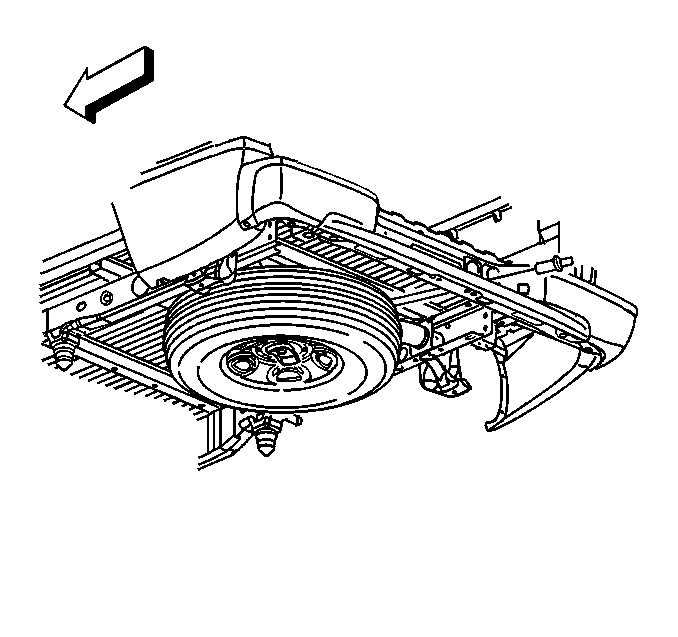
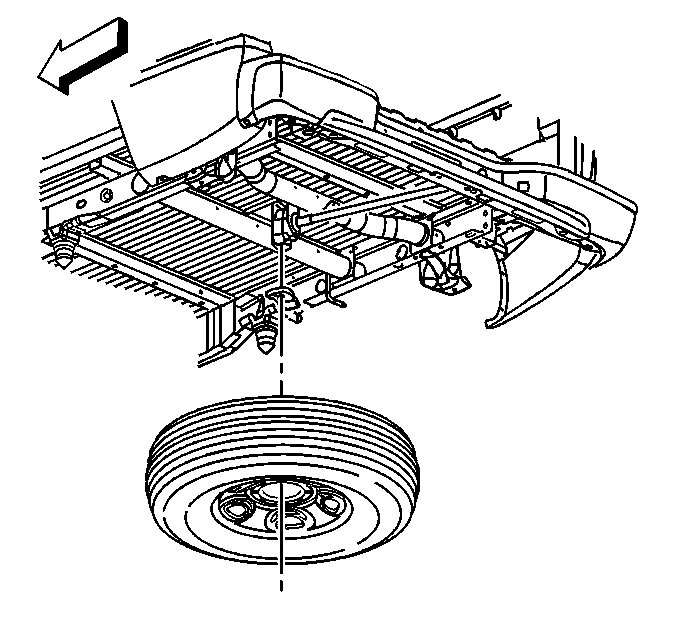
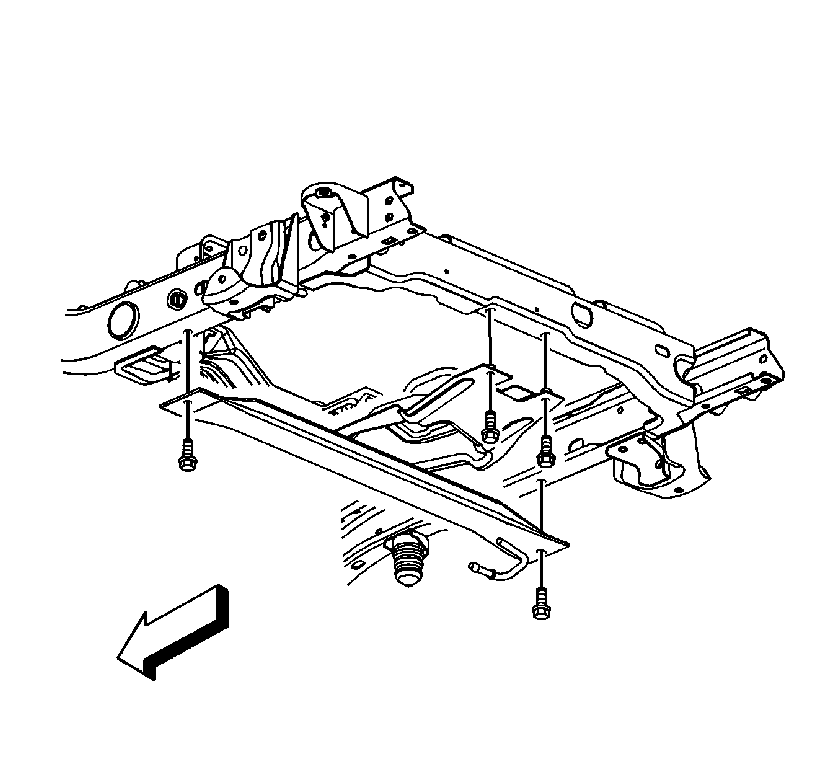
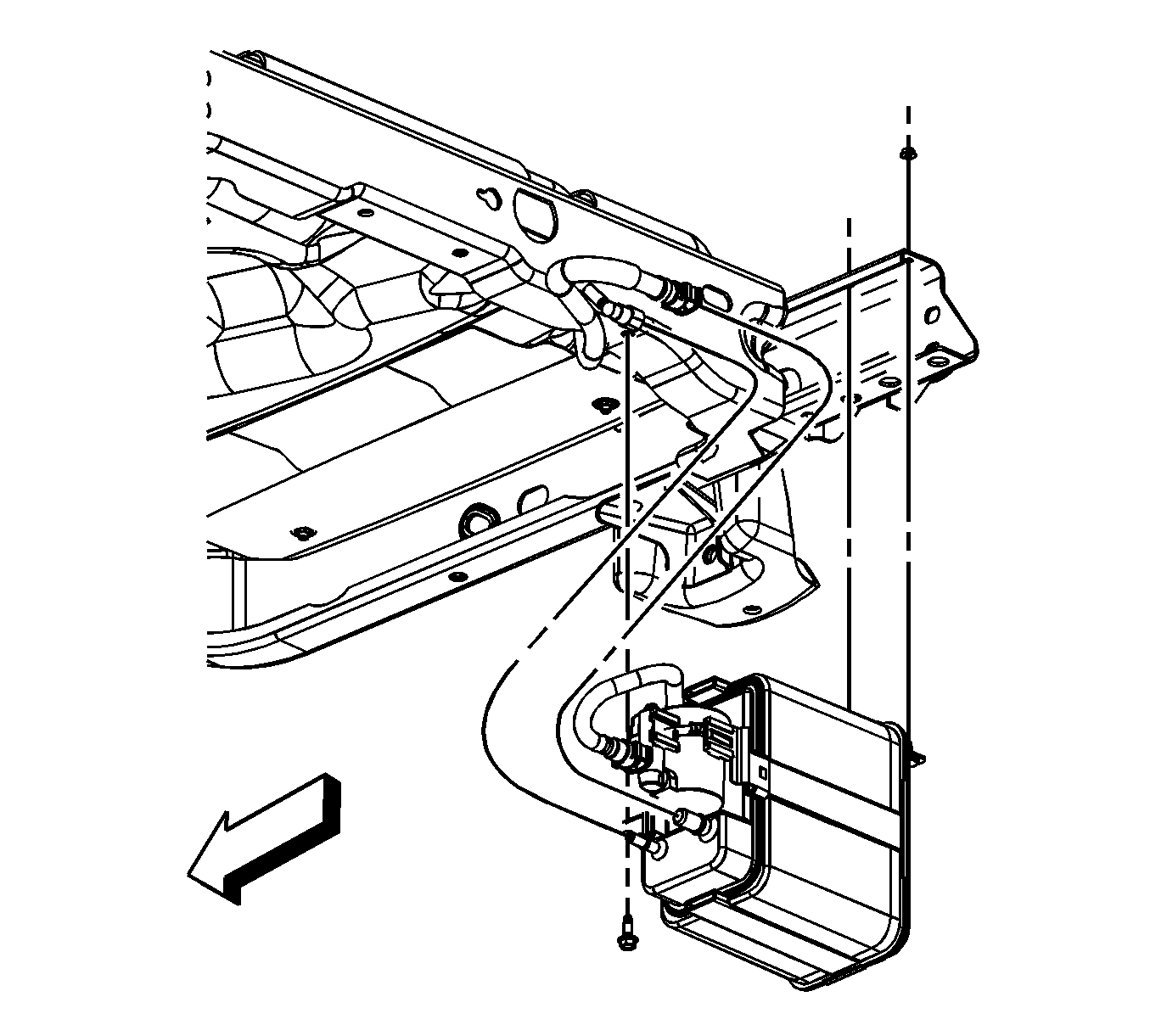
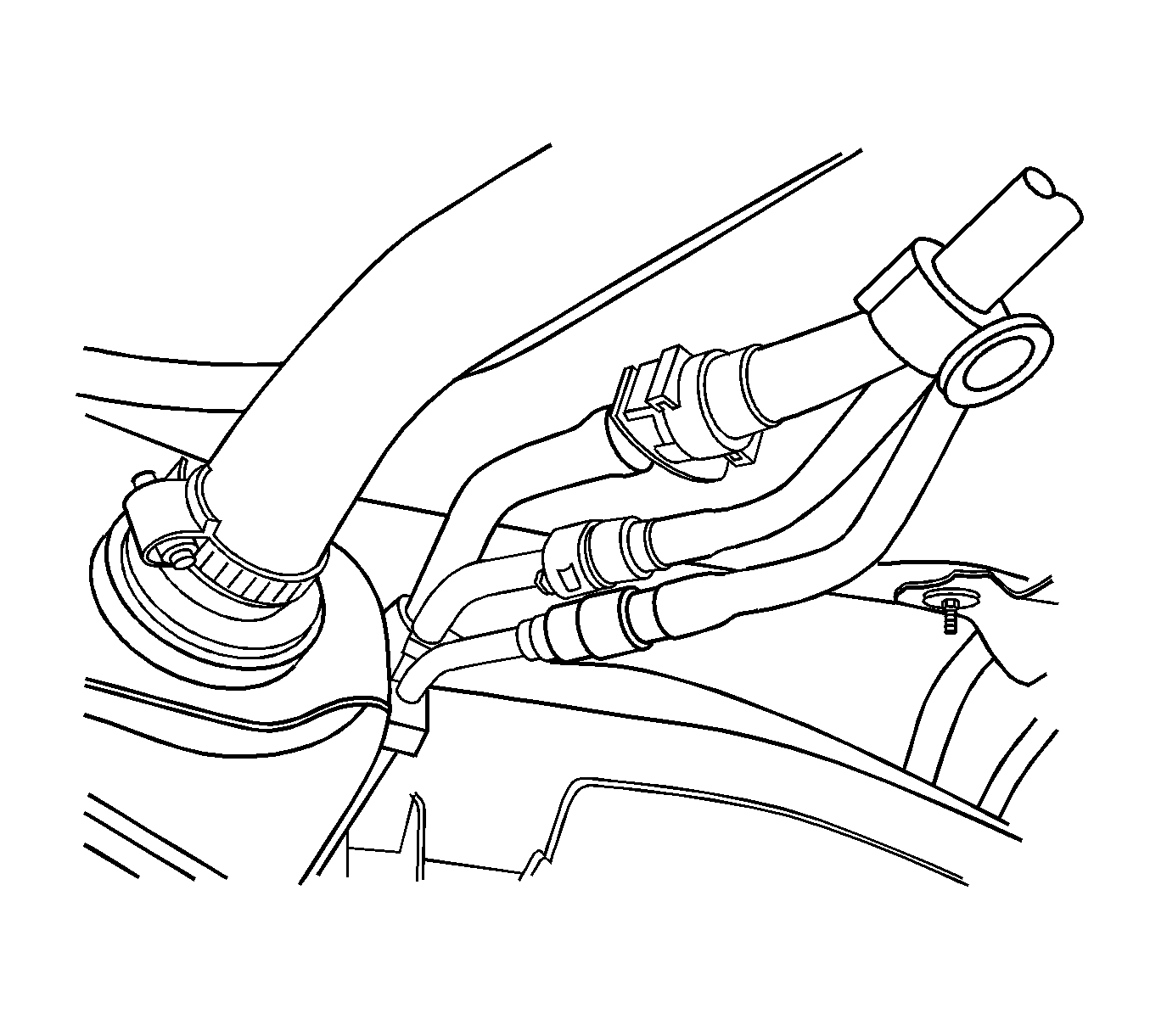
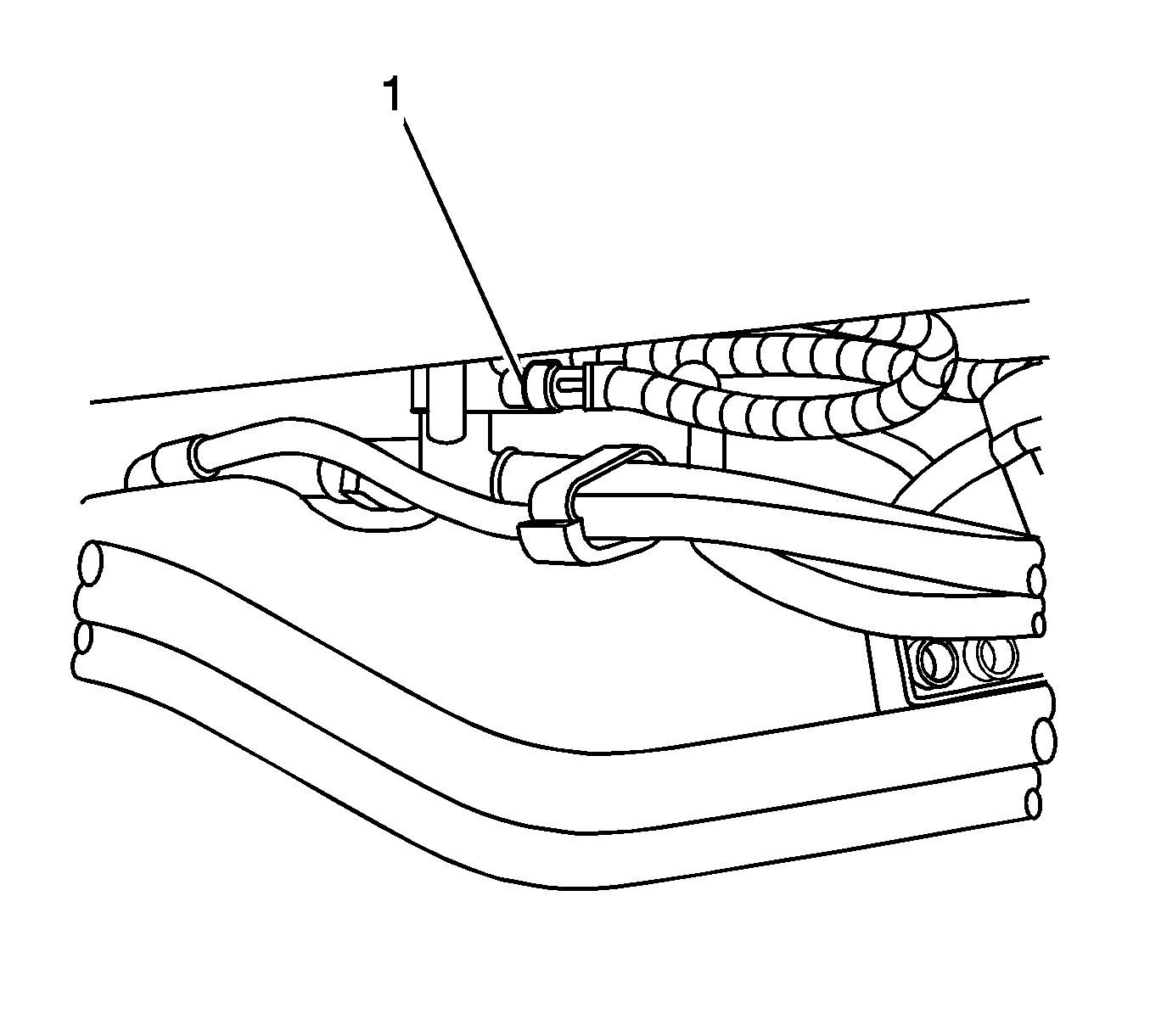
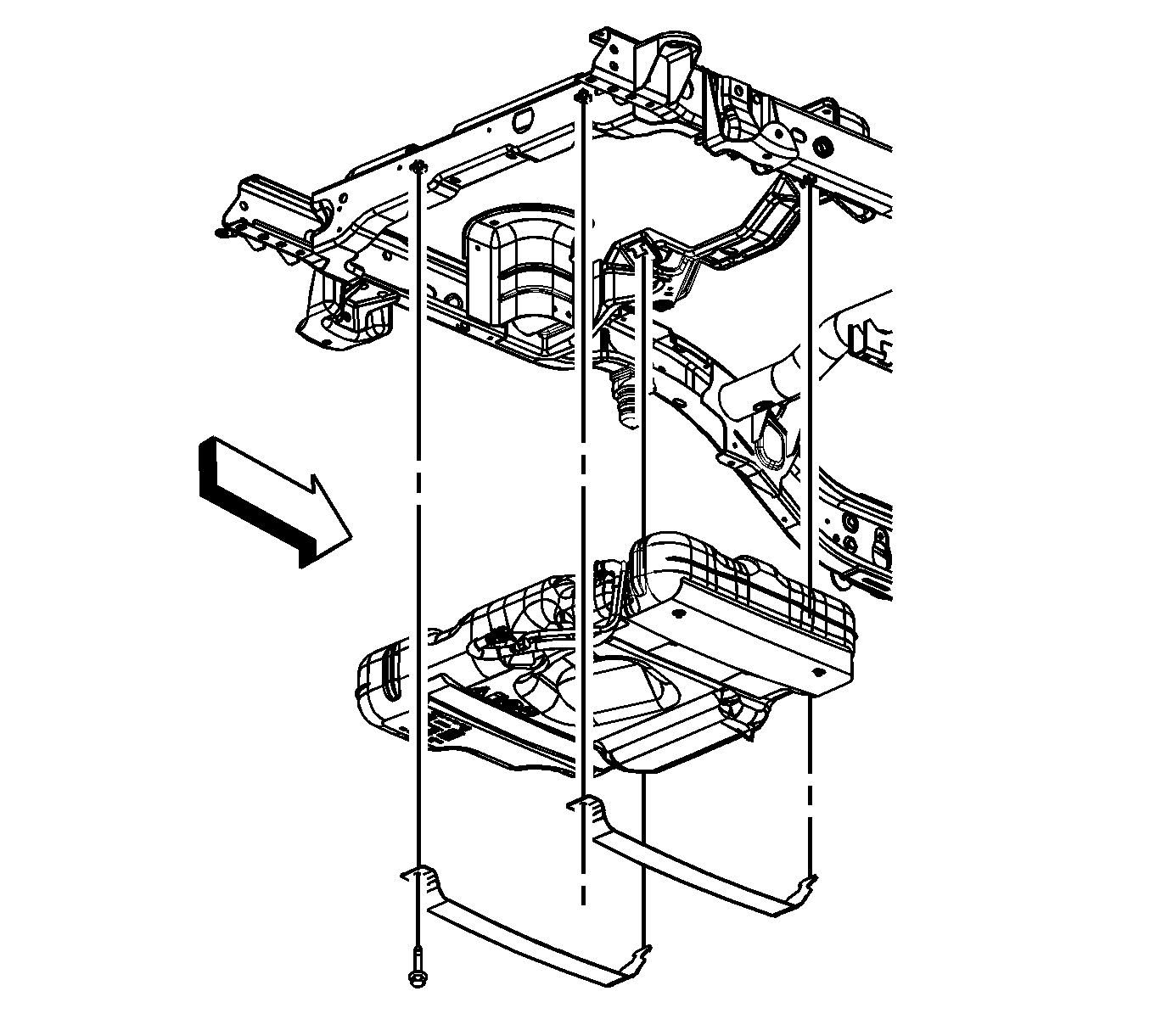
Notice: Do not bend the fuel tank straps. Bending the fuel tank straps may damage the straps.

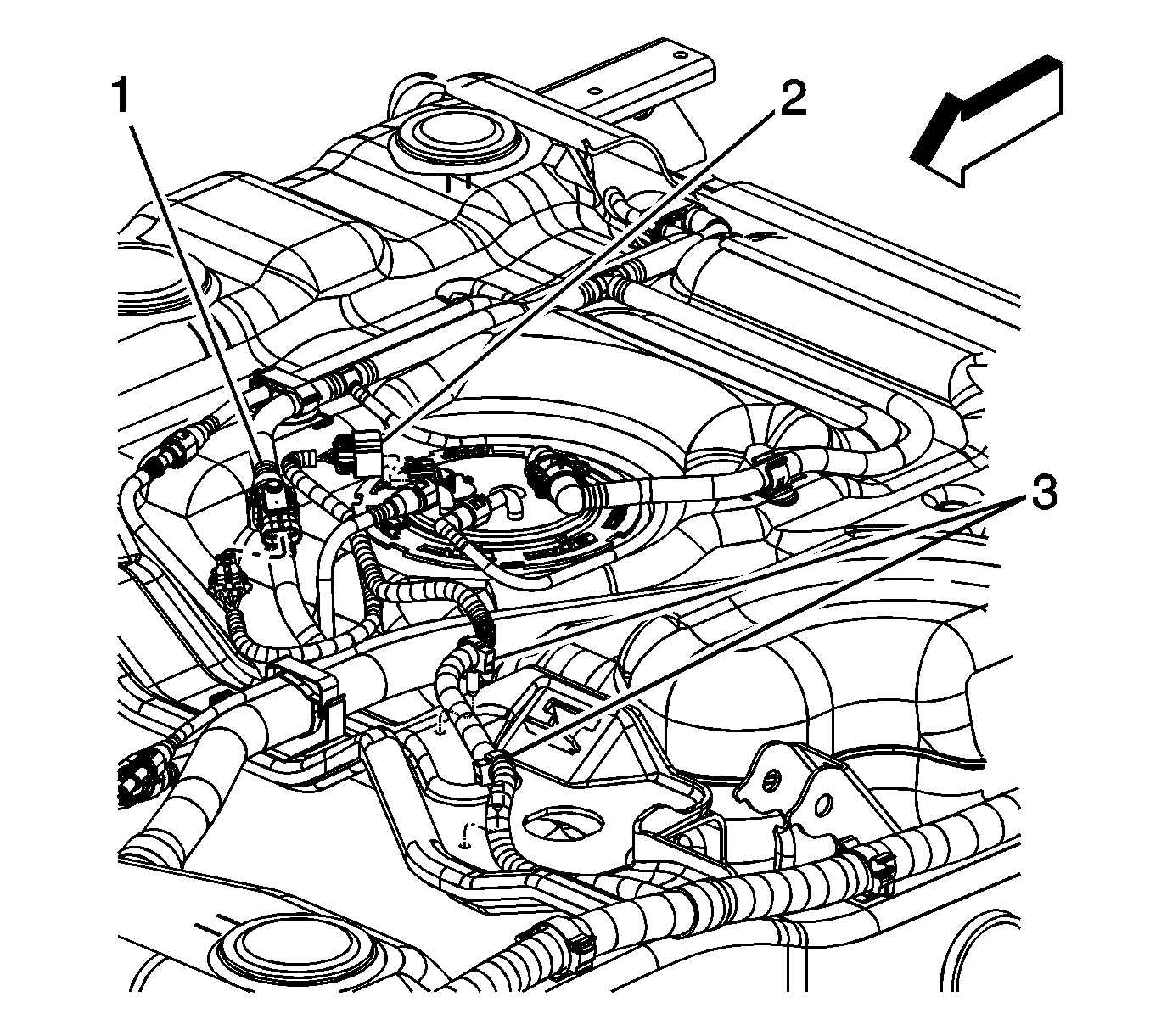
Installation Procedure
- If necessary, install the sending unit. Refer to Fuel Sender Assembly Replacement .
- With the aid of an assistant, install the tank onto the jack.
- Partially raise the fuel tank.
- Connect the sending unit electrical connector (2).
- Remove the caps from the fuel and EVAP lines.
- Install the fuel and EVAP intermediate lines.
- Connect the fuel and EVAP intermediate lines to the rear tank. Refer to Plastic Collar Quick Connect Fitting Service .
- With the aid of an assistant, completely raise the rear tank.
- Install the fuel tank straps.
- Install the fuel tank strap bolts.
- Remove the adjustable jack from under the fuel tank.
- Connect the fuel pressure sensor electrical connector (1).
- Connect the fuel and EVAP intermediate lines to the front tank. Refer to Plastic Collar Quick Connect Fitting Service .
- Connect the EVAP canister quick connect fittings. Refer to Plastic Collar Quick Connect Fitting Service .
- Install the spare tire hoist crossmember and bolts.
- Install the rear exhaust insulator.
- Install the spare tire.
- Install the spare tire stowage lock cylinder.
- Install the fuel tank filler housing.
- Install the fuel tank filler housing to fuel tank fill pipe bolts.
- Install the fuel tank filler housing to body TORX® screws (1) and retainer (2).
- Refill the fuel tank.
- Install the fuel fill cap.
- Connect the negative battery cable. Refer to Battery Negative Cable Disconnection and Connection in Engine Electrical.
- Use the following procedure in order to inspect for leaks:



Notice: Refer to Fastener Notice in the Preface section.
Tighten
Tighten the bolts to 40 N·m (30 lb ft).




Tighten
Tighten the bolts to 50 N·m (37 lb ft).


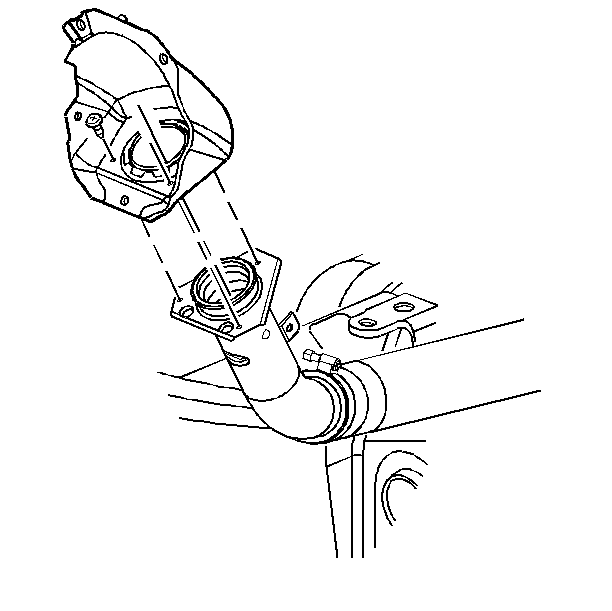
Tighten
Tighten the bolts to 2.3 N·m (20 lb in).
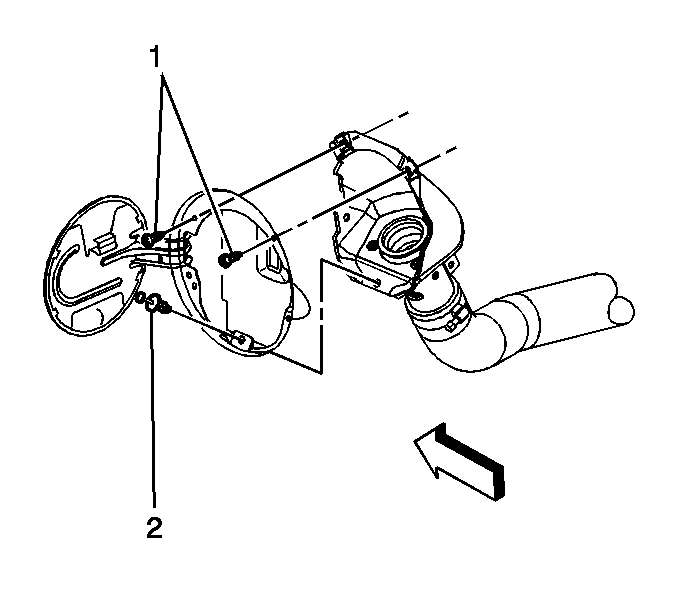
Tighten
Tighten the screws to 2.3 N·m (20 lb in).
| 25.1. | Turn the ignition ON, with the engine OFF, for 2 seconds. |
| 25.2. | Turn the ignition OFF for 10 seconds. |
| 25.3. | Turn the ignition ON, with the engine OFF. |
| 25.4. | Inspect for fuel leaks. |
Fuel Tank Replacement Single Tank w/5.3L (L59) Engine
Tools Required
J 43178 Fuel Line Disconnect Tool
Removal Procedure
Important: Clean the fuel and evaporative emission (EVAP) connections and surrounding areas prior to disconnecting the lines in order to avoid possible system contamination.
- Relieve the fuel system pressure. Refer to Fuel Pressure Relief .
- Drain the fuel tank. Refer to Fuel Tank Draining .
- Remove the evaporative emission (EVAP) canister. Refer to Evaporative Emission Canister Replacement .
- Loosen the vent hose clamp.
- Remove the vent hose from the fuel tank.
- Disconnect the chassis fuel pipe (4) from the fuel tank pipe (3). Refer to Plastic Collar Quick Connect Fitting Service .
- Using J 43178 , disconnect the chassis fuel pipe (4) from the fuel tank pipe (3).
- Cap the fuel and EVAP pipes in order to prevent possible fuel and/or EVAP system contamination.
- Using an adjustable jack, support the fuel tank.
- Lower the fuel tank slightly.
- Disconnect the EVAP vent pipe from the fuel tank clips (6, 7).
- Remove the fuel tank strap bolts.
- Remove the fuel tank straps.
- With the aid of an assistant, carefully lower the rear of the fuel tank.
- Slide the front of the tank away from the frame.
- If equipped, remove the sending unit shield nuts.
- If equipped, remove the sending unit shield.
- Release the connector position assurance (CPA) retainer.
- Disconnect the fuel sender and fuel pressure sensor electrical connectors (2).
- Completely lower the fuel tank.
- Place the fuel tank in a suitable work area.
- Remove the fuel feed and return pipes from the fuel sending unit and the retaining clips.
- If necessary, remove the fuel sending unit. Refer to Fuel Sender Assembly Replacement .
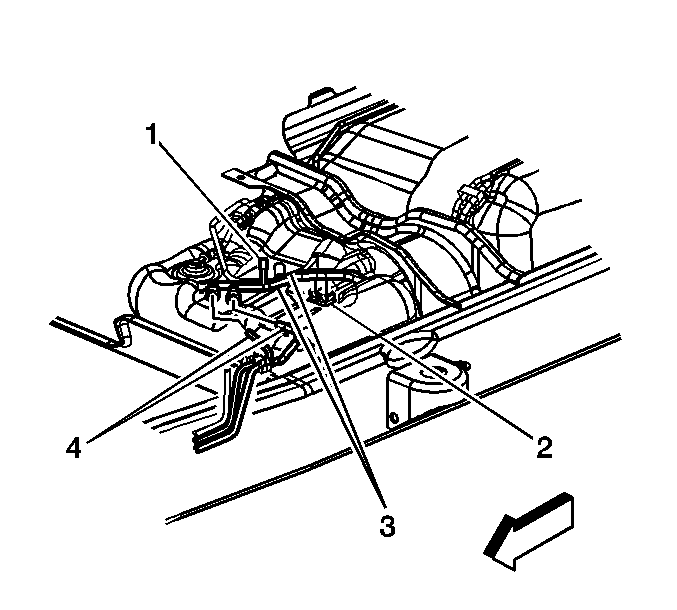

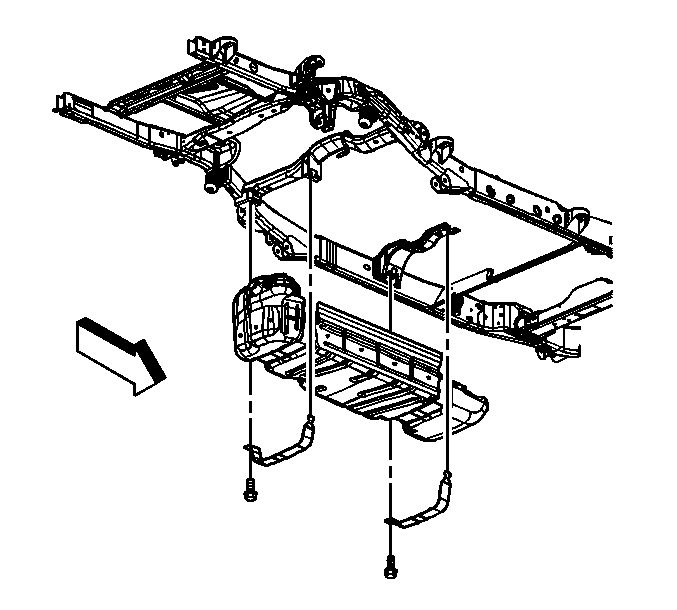
Notice: Do not bend the fuel tank straps. Bending the fuel tank straps may damage the straps.
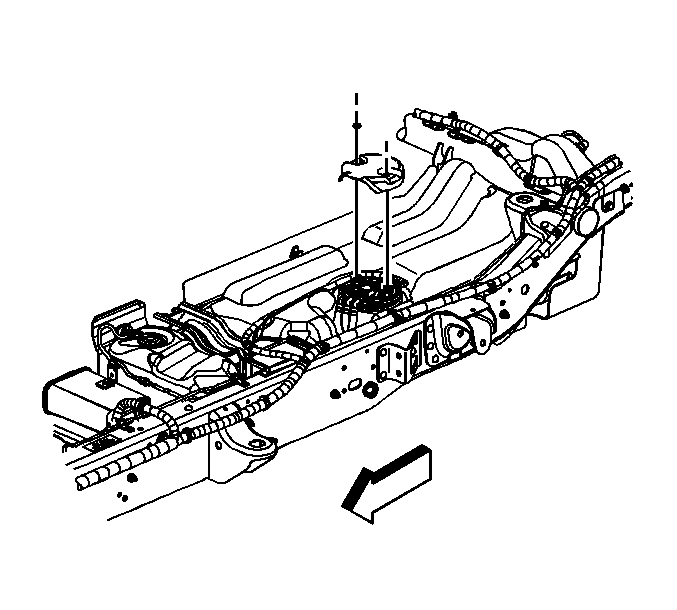

Installation Procedure
- If necessary, install the fuel sending unit. Refer to Fuel Sender Assembly Replacement .
- Connect the fuel feed and return pipes to the fuel sending unit and the retaining clips.
- Place the fuel tank onto a suitable jack.
- With the aid of an assistant, partially raise the fuel tank.
- Connect the fuel sender and fuel pressure sensor electrical connectors (2).
- Install the CPA retainer.
- If equipped, install the sending unit shield.
- If equipped, install the sending unit shield nuts.
- With the aid of an assistant, completely raise the fuel tank.
- Install the fuel tank straps.
- install the fuel tank strap bolts.
- Remove the adjustable jack from the fuel tank.
- Connect the vent hose and fill hose to the tank.
- Tighten the vent hose and fill hose clamps at the tank.
- Connect the EVAP vent pipe to the fuel tank clips (6, 7).
- Remove the caps from the fuel and EVAP pipes.
- Connect the chassis fuel pipes (4) to the fuel tank pipes (3). Refer to Plastic Collar Quick Connect Fitting Service .
- Install the EVAP canister. Refer to Evaporative Emission Canister Replacement .
- Lower the vehicle.
- Refill the fuel tank.
- Install the fuel fill cap.
- Connect the negative battery cable. Refer to Battery Negative Cable Disconnection and Connection in Engine Electrical.
- Use the following procedure in order to inspect for leaks:


Notice: Use the correct fastener in the correct location. Replacement fasteners must be the correct part number for that application. Fasteners requiring replacement or fasteners requiring the use of thread locking compound or sealant are identified in the service procedure. Do not use paints, lubricants, or corrosion inhibitors on fasteners or fastener joint surfaces unless specified. These coatings affect fastener torque and joint clamping force and may damage the fastener. Use the correct tightening sequence and specifications when installing fasteners in order to avoid damage to parts and systems.
Tighten
Tighten the nuts to 10 N·m (89 lb in).

Tighten
Tighten the bolts to 40 N·m (30 lb ft).
Tighten
Tighten the clamps to 2.5 N·m (22 lb in).


| 23.1. | Turn the ignition ON, with the engine OFF, for 2 seconds. |
| 23.2. | Turn the ignition OFF for 10 seconds. |
| 23.3. | Turn the ignition ON, with the engine OFF. |
| 23.4. | Inspect for fuel leaks. |
